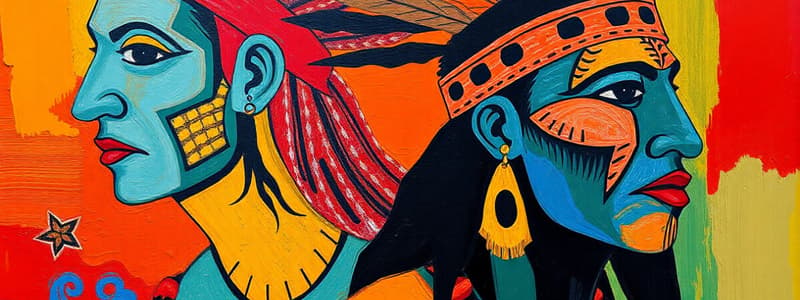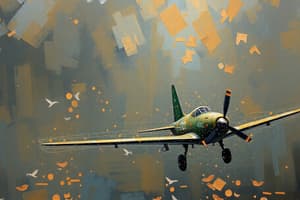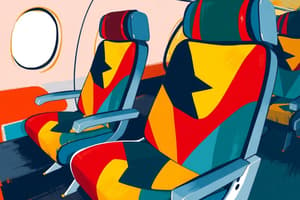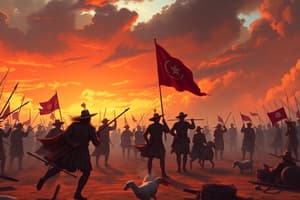Podcast
Questions and Answers
What was a primary reason Native American tribes migrated into Spanish Florida during the 1700s?
What was a primary reason Native American tribes migrated into Spanish Florida during the 1700s?
- To form alliances against the Spanish government.
- To establish trade routes with European settlers.
- To separate from the main body of the Lower Creek Indians. (correct)
- To escape conflicts with other tribes in the Southeast.
What role did the Spanish play in the alliances between the Seminoles and escaped slaves in Florida?
What role did the Spanish play in the alliances between the Seminoles and escaped slaves in Florida?
- The Spanish actively suppressed any alliances between Seminoles and escaped slaves.
- The Spanish were indifferent to the alliances but hoped they would deter American expansion. (correct)
- The Spanish facilitated the alliances by offering resources and support.
- The Spanish were primarily concerned with exploiting the Seminoles and slaves for labor.
In what way did Seminole enslavement practices differ from those of white settlers?
In what way did Seminole enslavement practices differ from those of white settlers?
- Seminoles subjected their slaves to harsher punishments and stricter control.
- Seminoles primarily used slaves for warfare and defense.
- Seminoles allowed their slaves greater freedoms and autonomy compared to white settlers. (correct)
- Seminoles focused on converting their slaves to Christianity and integrating them into the tribe.
What was a key factor that led to increased tensions between white settlers and the Seminole-black alliances in Florida?
What was a key factor that led to increased tensions between white settlers and the Seminole-black alliances in Florida?
How did the U.S. government attempt to resolve the conflict over escaped slaves in Florida after acquiring the territory in 1821?
How did the U.S. government attempt to resolve the conflict over escaped slaves in Florida after acquiring the territory in 1821?
What challenge did slave-catchers and the army face when trying to capture escaped slaves living among the Seminoles?
What challenge did slave-catchers and the army face when trying to capture escaped slaves living among the Seminoles?
Why was the Dade Massacre a pivotal event in the context of the Seminole-black alliance and American expansion?
Why was the Dade Massacre a pivotal event in the context of the Seminole-black alliance and American expansion?
What strategic error did Major Dade's forces commit after the initial Seminole attack?
What strategic error did Major Dade's forces commit after the initial Seminole attack?
In what way did the Seminole Wars differ from other conflicts between Native Americans and the U.S. government?
In what way did the Seminole Wars differ from other conflicts between Native Americans and the U.S. government?
In addition to kinship, what role did figures such as Negro Abraham play in the Seminole resistance?
In addition to kinship, what role did figures such as Negro Abraham play in the Seminole resistance?
What factor contributed to Abraham being described as a religious enthusiast and given the name 'Prophet'?
What factor contributed to Abraham being described as a religious enthusiast and given the name 'Prophet'?
What skill enabled John Horse to influence the Seminoles and Black Seminoles?
What skill enabled John Horse to influence the Seminoles and Black Seminoles?
What strategy did General Thomas Sidney Jesup employ to pressure the Seminoles into surrendering?
What strategy did General Thomas Sidney Jesup employ to pressure the Seminoles into surrendering?
What role did John Horse play in facilitating the relocation of Seminoles to the West?
What role did John Horse play in facilitating the relocation of Seminoles to the West?
What did the U.S. Government do to seemingly show appreciation for John Horse's work as a negotiator?
What did the U.S. Government do to seemingly show appreciation for John Horse's work as a negotiator?
What was one of John Horse's primary goals after relocating to the West?
What was one of John Horse's primary goals after relocating to the West?
What evidence suggests that the alliance between blacks and Seminoles had long-lasting effects?
What evidence suggests that the alliance between blacks and Seminoles had long-lasting effects?
What ultimately happened to the people who had sought land in Mexico?
What ultimately happened to the people who had sought land in Mexico?
When was Seminole Tribe in Florida officially recognized by the U.S. government?
When was Seminole Tribe in Florida officially recognized by the U.S. government?
What was the nature of the third Seminole War?
What was the nature of the third Seminole War?
Flashcards
Blacks and Seminoles Alliance
Blacks and Seminoles Alliance
An alliance formed between several Native American tribes and groups of black maroons/escaped slaves.
Who were the Seminoles?
Who were the Seminoles?
Seminoles were Native Americans mainly of Creek origin that migrated into Spanish Florida. The term means "seceders".
Seminoles' alliance with the Spanish
Seminoles' alliance with the Spanish
The Seminoles allied with the Spanish, offering refuge to escaped slaves and challenging English settlers in Florida.
Florida Maroon Communities
Florida Maroon Communities
Signup and view all the flashcards
Seminole and Black maroon cooperation
Seminole and Black maroon cooperation
Signup and view all the flashcards
Black Seminole Lifestyle
Black Seminole Lifestyle
Signup and view all the flashcards
Seminole System of Enslavement
Seminole System of Enslavement
Signup and view all the flashcards
Seminole Patrons
Seminole Patrons
Signup and view all the flashcards
Escaped slaves being returned
Escaped slaves being returned
Signup and view all the flashcards
Distinguishing between escaped slaves and Black Seminoles
Distinguishing between escaped slaves and Black Seminoles
Signup and view all the flashcards
Black Seminoles Carrying Arms
Black Seminoles Carrying Arms
Signup and view all the flashcards
Vengeance after Negro Fort
Vengeance after Negro Fort
Signup and view all the flashcards
Manipulation for Fugitive Slaves
Manipulation for Fugitive Slaves
Signup and view all the flashcards
Blacks and Seminoles Alliance cemented
Blacks and Seminoles Alliance cemented
Signup and view all the flashcards
Black and Indian Attack on Dade
Black and Indian Attack on Dade
Signup and view all the flashcards
Luis Pacheco
Luis Pacheco
Signup and view all the flashcards
Negro Abraham's Role
Negro Abraham's Role
Signup and view all the flashcards
John Horse's Rise
John Horse's Rise
Signup and view all the flashcards
General Jesup's Tactic
General Jesup's Tactic
Signup and view all the flashcards
Study Notes
The Alliance of Blacks and Seminoles
- As early as the 1700s, Native American tribes migrated to Spanish Florida.
- Most were Lower Creek Indians from eastern Alabama and southern Georgia.
- They were called Seminoles, meaning seceders.
- Their leader Cowkeeper allied with the Spanish to keep English settlers out of Florida.
- Florida was a haven for escaped slaves since the time of the conquistadors.
- The Seminoles found former slaves and maroons already living free in Florida.
- Florida maroons were primarily escaped slaves.
- Florida maroons preferred their own communities, separate from whites, slaves, and Indians.
- Maroons maintained African-oriented societies.
- Maroons and Seminoles sometimes joined forces to attack white settlers.
- Escaped slaves and Seminoles formed mutually supporting communities with no Spanish resistance.
- They resisted American troops sent to remove Indians and return slaves.
- Some blacks owned by Indians came to Florida with their masters as gifts from the British, these were known as Black Seminoles.
- Black Seminoles had freedoms similar to their Indian masters.
- Indians and blacks armed themselves and assembled under respective captains during conflicts.
- Blacks served as interpreters for the Indians with the American military.
- The Seminoles’ enslavement system was benign compared to that of the English and Americans.
- The Seminoles supplied their slaves with tools to build houses for themselves, and the "masters" received a third of the crop as a tribute.
- Seminole patrons did not meddle when blacks acquired livestock, and supplied them with livestock at slaughtering time.
- The Seminoles established Cuscowilla, their town, west of St. Augustine.
- Cowkeeper allied with the Spanish to keep English settlers out of Florida.
- Approximately 5,000 Indians migrated into Spanish Florida during the eighteenth and nineteenth centuries.
- Both Indians and escaped black slaves were welcomed by the Spanish.
- The Spanish wanted them to discourage white American expansion.
- The alliance between the Indians and the blacks produced escalating tensions because white slave-owners wanted their slaves back.
- The Seminoles had no intention of turning over their slaves, some of whom had married into the tribe.
- The Seminoles gave shelter to escaped slaves.
- When Florida became a U.S. territory in 1821, the American government demanded the return of all escaped slaves and closed the new Florida Territory to free blacks.
- Distinguishing escaped slaves from Black Seminoles became a problem.
- There were few differences between the two groups, except for the annual tribute.
- Sometimes escaped slaves and Black Seminoles had children which caused issues on their legal status.
- A few blacks were married to Seminole women, complicating the conflict.
- There was also the problem of blacks bearing arms.
- Seminole slaves were not supervised and were allowed to carry arms.
- During conflicts, black men armed themselves and fought American troops.
- By the early 1800s, escaped slaves were streaming into Florida and living near Indians or in black towns.
- The Seminoles and their black allies vowed vengeance after the Negro Fort was attacked.
- In 1823, the American government and the Seminoles signed the Treaty of Moultrie Creek which ceded land to the Americans.
- The interior of the peninsula was to become a Seminole reservation.
- The Americans manipulated the Indians into returning fugitive slaves for rations and it seemed to be working.
- By 1826, the Indians reportedly surrendered fugitive blacks.
- The Black Seminoles continued their migration with the Indians to remote camps.
- President Andrew Jackson signed the Indian Removal Act in May of 1830.
- The Act required most of the southern tribes to be removed to Indian Territory in the West (Oklahoma and Arkansas).
- The law moved the five civilized Tribes so that their lands could be settled by the white population.
- The passage of this law only cemented the alliance of blacks and Seminoles.
- The two groups vowed to resist removal from Florida.
- The conflict came to a critical point with the Dade Massacre in 1835.
- The U.S. government had negotiated the Treaty of Moultrie Creek which stipulated the Indians inhabited central Florida while whites inhabited the coasts.
- Major Francis L. Dade was sent to Fort King, near Ocala to reinforce troops.
- Dade and his men did not request permission to enter Seminole territory.
- On December 28, 1835, blacks joined the Indians at the Great Wahoo Swamp and attacked Dade's forces in central Florida.
- Two companies led by Major Francis L. Dade were taking a six-pound cannon to Fort King.
- As Dade was cheering his men on, the Indians fired at them.
- The battle might have ended then, except for an astonishing development.
- Dade's decimated forces chopped down small pine trees and formed a triangular fortification.
- In a final deadly assault, the Indians stormed the small fortification and overwhelmed the soldiers, leaving no one standing.
- The weapons were gathered and the Indians left, taking their three dead with them.
- The bodies remained unburied for weeks.
- Fifty-four days after the battle, an army of eleven hundred men reached the battleground.
- From a force of 107 men, only three survived.
- The black survivor of the Dade Massacre was Luis Pacheco, an interpreter who had acted as an interpreter for Major Dade.
- Pacheco was born a slave on a plantation south of Jacksonville.
- He learned to read and write from his master's daughter once.
- Pacheco went along as an interpreter with the Seminoles, whose language he had learned as a youth when Major Dade headed out of Tampa to march North.
- It has been asserted, but not established, that Pacheco disclosed the troop's movements to the Seminoles.
- When the Seminoles had attacked that morning, Pacheco had dropped to the ground pretending to be dead.
- At the right moment, he rose and presented himself as a slave and was spared.
- Thereafter, Pacheco was Jumper's slave and was sent West.
- Some 57 years after the Dade Massacre, Pacheco located the woman who had taught him to read and write and remained with her until he died in 1895.
- Following the Dade Massacre, a huge army of American soldiers was deployed to Florida.
- The event had made news all over America.
- This crushing Indian victory came several decades before the better-known massacre of General George Armstrong Custer and his troops at the Battle of the Little Big Horn in 1876 in Montana.
- In the aftermath of the Dade Massacre, the Seminoles and their black allies withdrew farther and farther south on the peninsula.
- Following the national policy of Indian removal, General Edmund P. Gaines waged a campaign against the Seminoles and blacks in Florida.
- This War came to be know as the Second Seminole War (1835-1842).
- General Gaines and his troops forced the Indians and blacks away from the Suwannee River.
- Some bands fell back to the Withlacoochee River, east and south of the Suwannee.
- It was during this time that Osceola rose to influence as one of the fiercest Seminole warriors.
- Throughout the conflict, as the Indians found themselves having to deal with the American government, black leaders emerged to help them.
- One of the first of these men was Negro Abraham who was born around 1770.
- Abraham is thought to have once been the slave of Dr. Eugenio Antonio Sierra of Pensacola.
- By 1826, he had become a translator.
- Abraham came to prominence following the death of the feared black fighter called Nero who was killed during Andrew Jackson's attacks on Indian and black settlements in the Suwannee River region.
- Abraham was described as a religious enthusiast, having traits that won him the name "Prophet."
- American Army recognized Abraham as having more influence upon Micanopy than did any of the Seminole chiefs of the day.
- Micanopy consulted Abraham before making any important decisions related to the hostilities with whites.
- Abraham plotted with Micanopy and his chiefs to begin an uprising against removal to Indian reservations in the West.
- It was Abraham who acted as interpreter for the Indians in the so-called Treaty of Payne's Landing in 1833.
- John Horse was another prominent black who influenced the Seminoles.
- Born in 1812, he was the son of a young black woman and an unknown father.
- He had many aliases, including Gopher John and John Cavallo, the latter name taken from the man who was likely his father.
- When the attack on Negro Fort occurred in 1816, John was four years old and living among the Seminoles on the Alachua Savannah, west of St. Augustine.
- By 1826, if not earlier, he was living in a village on Thlonotosassa Lake, twelve miles from Fort Brooke on Tampa Bay.
- He was able to communicate with his Indian friends in their own language or dialect.
- More important was the fact that he could also speak English fluently.
- During the time of the Second Seminole War, his relationship with Indian leaders bloomed.
- He grew into a powerfully-built man.
- His was growing into a fine and powerful man.
- He was also developing into a man of intellect and courage.
- He became a leader among his own people and to have great influence among the Seminoles.
- By November of 1836, a new commander had been appointed to assume control of American forces in Florida.
- He was General Thomas Sidney Jesup, the man after whom Jesup, Georgia is named.
- He tried a different tactic to deal with the Seminoles by trying to capture their women and children.
- Most came in.
- With an effective and large military force now operating in Florida, many Indians were being rounded up for removal, and black leaders found it more difficult to survive in Florida.
- John Caesar, the black man who had attacked plantations in the St. Johns area, was killed on January 17, 1837, one day after he reportedly attempted to steal horses from the Hanson Plantation two miles west of St. Augustine.
- But many of the chiefs were still at large, accompanied by Indian and black warriors.
- They were now constantly on the move, trying to avoid the roving bands of American soldiers.
- General Jesup eventually made contact with the omnipresent Negro Abraham, and through him, began communicating with the Seminoles.
- General Jesup and Abraham met in Jesup's camp on January 31, 1837.
- Abraham had been sent to the meeting by Micanopy to speak for the Seminoles and, of course, for the blacks.
- After Abraham's meeting with the general, Seminole leaders soon gathered to begin negotiations to end the war.
- On March 6, 1837, they arrived at Fort Dade to meet with General Jesup.
- It was during these discussions that John Horse, already known and respected in the Seminole and Black Seminole communities, first gained the notice of the Americans.
- Negotiations between the Seminoles and the Americans were concluded by a document stating that hostilities were to cease immediately and permanently
- It stipulated that the entire Seminole population would emigrate to the West.
- The United States would pay their relocation expenses
- The Seminoles were to receive government rations before and during removal, and for a year after.
- John Horse was one of the signatories of the document on behalf of Chief Alligator.
- Through dogged persistence, Jesup finally persuaded most of the exhausted Indians in these bands to come in.
- By mid-April, even Alligator and John Horse had arrived at Fort Bassinger for emigration.
- In June, 1838, John Horse and his family were sent to relocation camps in the West.
- There were still some isolated bands at large, and the war slogged along in Florida.
- While John Horse and his family were on the way to relocation, General Zachary Taylor asked for some of the Seminole chiefs to be sent back to Florida.
- John Horse expressed his wish to join the envoy of Seminoles.
- John Horse was allowed to reach Florida where he once again became a prominent figure.
- He worked as a guide and interpreter.
- He also began helping the government convince the few remaining Seminoles to emigrate.
- John was doing well for himself and dressed in nice clothes.
- John Horse continued his services in helping to relocate the Indians.
- He helped continue Taylor's plan to bring a few chiefs back from the West to induce the remainder of the Florida Indian population to emigrate.
- Hundreds of blacks were removed from Florida and taken west with the Seminoles.
- Some Florida blacks became famed Buffalo Soldiers.
- By 1842, John Horse's duties were becoming fewer and fewer.
- He left Florida on July 14, 1842, as a free man.
- He and other Black Seminoles lived in Oklahoma, Texas, and Mexico.
- He became a prime spokesman for the cause of obtaining land in the West for the Black Seminoles.
- On August 10, 1882, his quest finally ended.
- In March, 1884, the blacks and the Indians who had so earnestly sought their own land were allowed to remain in the settlement of Nacimiento in Mexico.
- The Seminole wars had been costly for the new country in lives and money.
- On May 8, 1858, the United States declared that the Third Seminole War (1855 to 1858) had ended.
- About 200 Seminoles remained in Florida by that time.
- A few Black Seminoles also remained.
- Their descendants live there today, west of Miami and in the Everglades and Big Cypress regions.
- In 1957, the Seminole Tribe of Florida was officially recognized by the U.S. government.
- There are Black Seminole reunions held in south Florida, there are also black envoys from the West.
- In the end, the alliance between blacks and Seminoles resulted in a measure of intermarriage, or at least inter-breeding, and ultimately the presence of racially mixed descendants among the Seminoles today.
- Ties between blacks and Seminoles is common knowledge.
- The colored people spoke the Indian language and they spoke English.
- Intermarriage between blacks and Seminoles was not encouraged.
Studying That Suits You
Use AI to generate personalized quizzes and flashcards to suit your learning preferences.




